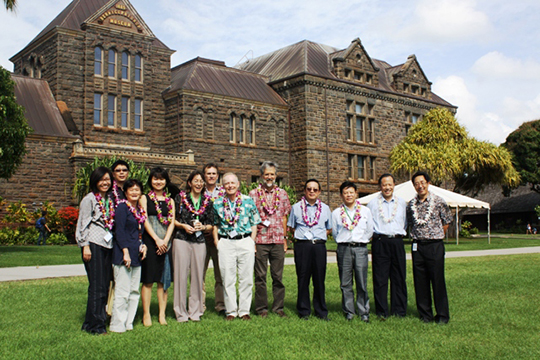The Centre for Chinese Archaeology and Art (CCAA) has conducted studies on barkcloth, prehistoric jades and early rotary technologies over the past two decades, which have earned international academic interest. Below are the latest and forthcoming developments in barkcloth research.  Barkcloth and its distribution Barkcloth and its distribution
Barkcloth is a non-woven fabric that is primarily made by beating the fibrous inner bark of suitable trees. Widely used across the tropics until the sixteenth century, it is still a defining feature of Austronesian material and spiritual culture in the Pacific islands. CCAA's research on barkcloth and its implications The CCAA has been investigating the origins of barkcloth since the 1990s. In 1996, it excavated three 6,000-year-old barkcloth stone tools (barkcloth beaters) on Lamma Island, Hong Kong. In the early 2000s, the Director of the CCAA, Professor Tang Chung, received RGC funding to establish a comprehensive chronological database of prehistoric barkcloth beaters in Southeast Asia. Over the past 20 years, the CCAA has excavated numerous barkcloth beaters in Hong Kong and northern Vietnam, and collected information on the beaters held by museums in Yunnan, Guangxi, Guangdong, Fujian and Hainan provinces. Furthermore, in the mountains of Yunnan and Hainan, it rediscovered ethnic minorities that had worn barkcloth in the past and could still replicate its production process. Until very recently, academics had virtually no knowledge of the origins of barkcloth in South China. The Chinese University of Hong Kong's research has reconstructed the prehistoric barkcloth clothing system of Hong Kong, South China and Southeast Asia. This newly established clothing system is also the earliest barkcloth culture known to date, opening exciting new paths for investigation. Most recently, the CCAA has been working with Xiamen University to analyse the function of barkcloth stone beaters through a paleobotanical approach by studying their starch grain residues. Touring exhibitions and international symposium The projects described above have laid the foundations for the exhibitions on "Origins of Clothes—Barkcloth" at the Chinese University of Hong Kong and the Zhuhai Museum in 2011 and 2012, respectively. To expand the scope in time and space, the CCAA is currently co-organizing an international touring exhibition with the Bishop Museum, which is a leading institute in anthropological studies in the Pacific.¬ Dr. Tianlong Jiao, Chairman of the Department of Anthropology at the Bishop Museum, visited the Chinese University of Hong Kong on 13-15 November 2012, where he gave a lecture and discussed our forthcoming joint exhibition on the global history of barkcloth. On 13-16 January 2013, the CCAA was invited to make a presentation at the Bishop Museum's international symposium on Archaeology and Heritage Conservation Across the Taiwan Strait and Related Regions. Fourteen professors and researchers from Hawai'i, Taiwan, Hainan, Hong Kong and mainland China gathered at the conference in Honolulu. Professor Tang and Research Assistant Mana Tang presented a paper on "Origins of Barkcloth in East Asia: An Archaeological Perspective", which discussed the origins and cultural dispersal of the Austronesian-speaking people. This conference was later featured in the World Journal in North America. The Bishop Museum holds one of the world's largest barkcloth collections from the Pacific. To enhance our future collaboration, the curators especially showed us their rich collection of pre- and post-Western contact barkcloth and its production tools, which is an important ethnographic resource for the study of the surviving Pacific descendants of prehistoric barkcloth traditions in continental Southeast Asia. Global significance of barkcloth origin studies Silk and barkcloth from China are inventions with widespread geographical influence in the history of human clothing. To date, the CCAA has determined that barkcloth technologies spread from South China to the Southeast Asian peninsula and its islands in prehistoric times, crossing into the Pacific and reaching as far as Mesoamerica. At present, the CCAA is making plans with the Bishop Museum to conduct multidisciplinary research on barkcloth technologies and traditions around the world. A joint international touring exhibition will feature the history of barkcloth from East Asia to Mesoamerica, and it is expected to be on display in Hong Kong in 2015. 
|














